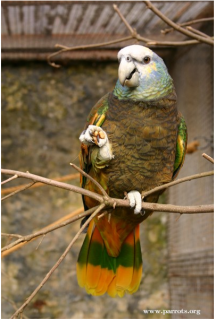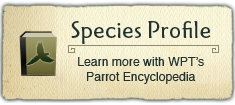Project Regions:
St. Vincent Amazon |
|
|
Collaborators/Funders
Andrew Greenwood, DVM, St. Vincent Dept of Natural Resources
Island parrot's numbers down to less than 800 individuals
Wild populations of the St. Vincent’s Amazon (Amazona guildingii) have been devastated by trapping for the live bird trade, hunting, and loss of habitat and nesting trees.
Project and progress: St. Vincent's Amazons have benefited from WPT's support for:
- Population counts and habitat usage
- Aiding breeding population in captivity
- Educational material via a purpose-built bus
Outcomes: From 1990 to 2001, the World Parrot Trust supported the St. Vincent Amazon by providing veterinary help (Andrew Greenwood, 1994), funds to carry out much needed surveys of populations and habitat, and aviary construction for captive breeding populations. The Trust has also produced a very successful series of conservation educational buses in Central America, including one for the island of St. Vincent. Researchers have suggested to continue to monitor the population and build on existing protective measures, including the development of the captive breeding programme. They also recommend researching the reproductive biology and movements of the species.
World population: about 734 individuals
Where found: Located only on the island of St. Vincent in the Lesser Antilles, West Indies.
History: The St. Vincent’s Amazon (Amazona guildingii) is found on the upper west and east ridges of Mt. Soufriere on the island of St. Vincent. The species’ greatest declines occurred in the 20th century until the early 1980s and was caused by trapping for the live bird trade, subsistence hunting, and loss of habitat and nesting sites from forestry and agriculture. These human pressures have resulted in a listing of Vulnerable by IUCN, Appendix I by CITES.
Threats:
- Hunting for food
- Trapping for the cage-bird trade
- Habitat loss and conversion to agriculture
- Loss of nest trees from poachers
- Severe weather and volcanic activity
- Introduction of species such as the nine-banded armadillo (Dasypus novemcinctus)
- Plans for a cross-country road that would increase deforestation
- Genetic isolation of separate subpopulations
Ecology: This parrot inhabits mature moist forest at an elevation of 125 to 1000m (410-3280 ft), with occasional visits to cultivated areas and gardens. It feeds on the flowers, nuts, fruits and seeds of many plants such as Ficus, Clusia and Cecropia. Gregarious and usually in flocks of 20 to 30 birds, this Amazon is otherwise seen in pairs; birds will defend area around nest while breeding but will allow flocks of a dozen birds to be in the same area while feeding and roosting.


































